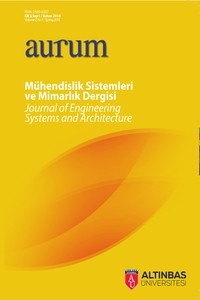Yapay Zeka Kullanarak Karmaşık Bir Ortamda Robotları Hareket Ettirme
Robotik, Yapay Sinir Ağları, Takviye Öğrenimi, Işık Tespiti ve Değişimi
Navigating Robots in a Complex Environment with Moving Objects Using Artificial Intelligence
Robotics, Artificial Neural Networks, Reinforcement Learning, Light Detection and Ranging,
___
- Bottou, L. 2014. From machine learning to machine reasoning. Machine learning, 94(2), 133-149.
- Choi, J., Park, K., Kim, M., & Seok, S. 2019. Deep Reinforcement Learning of Navigation in a Complex and Crowded Environment with a Limited Field of View. Paper presented at the 2019 International Conference on Robotics and Automation (ICRA).
- Ha, D., & Schmidhuber, J. 2018. Recurrent world models facilitate policy evolution. Paper presented at the Advances in Neural Information Processing Systems.
- Kahn, G., Villaflor, A., Pong, V., Abbeel, P., & Levine, S. 2017. Uncertainty-aware reinforcement learning for collision avoidance. arXiv preprint arXiv:1702.01182.
- Kim, K.-S., Kim, D.-E., & Lee, J.-M. 2018. Deep Learning Based on Smooth Driving for Autonomous Navigation. Paper presented at the 2018 IEEE/ASME International Conference on Advanced Intelligent Mechatronics (AIM).
- Lillicrap, T. P., Hunt, J. J., Pritzel, A., Heess, N., Erez, T., Tassa, Y., . . . Wierstra, D. 2015. Continuous control with deep reinforcement learning. arXiv preprint arXiv:1509.02971.
- Littman, M. L. 1994. Markov games as a framework for multi-agent reinforcement learning Machine learning proceedings 1994 (pp. 157-163): Elsevier.
- Mnih, V., Kavukcuoglu, K., Silver, D., Graves, A., Antonoglou, I., Wierstra, D., & Riedmiller, M. 2013. Playing atari with deep reinforcement learning. arXiv preprint arXiv:1312.5602.
- Mnih, V., Kavukcuoglu, K., Silver, D., Rusu, A. A., Veness, J., Bellemare, M. G., . . . Ostrovski, G. 2015. Human-level control through deep reinforcement learning. Nature, 518(7540), 529.
- Robert, C. 2014. Machine learning, a probabilistic perspective: Taylor & Francis.
- Silver, D., Hubert, T., Schrittwieser, J., Antonoglou, I., Lai, M., Guez, A., . . . Graepel, T. 2018. A general reinforcement learning algorithm that masters chess, shogi, and Go through self-play. Science, 362(6419), 1140-1144.
- Tan, M. 1993. Multi-agent reinforcement learning: Independent vs. cooperative agents. Paper presented at the Proceedings of the tenth international conference on machine learning.
- Watkins, C. J., & Dayan, P. 1992. Q-learning. Machine learning, 8(3-4), 279-292.
- ISSN: 2564-6397
- Yayın Aralığı: Yılda 2 Sayı
- Başlangıç: 2017
- Yayıncı: Altınbaş Üniversitesi
Beyin Epilepsi Tespitini Kullanarak Doğruluk Geliştirme Makina Öğrenme Algoritmaları
Rand AL-DAHHAN, Osman Nuri UÇAN
Laboratuvar Lazer Sistemi İçin Düşük Maliyetli Yüksek Hızlı Veri Toplama Kartı
Osman Nuri UÇAN, Oğuz BAYAT, Baraa SAAD ABDULHAKEEM
Laıth AWAD, İbrahim KOÇ, Salah JAWAD
İş Süreçlerinin Etkinliğini Arttırmak İçin Anahtar Değer Akışı Yaklaşımı
Semra BİRGÜN, Kemal Guven GULEN
Turizm Tesislerinin Pandemi Refleksi: Club Patara Örneklemi Üzerinden Değişen Mekansal Deneyimler
Yapay Zeka Kullanarak Karmaşık Bir Ortamda Robotları Hareket Ettirme
Omar YASEEN, Osman Nuri UÇAN, Oğuz BAYAT
Yapay Sinir Ağı Kullanarak Meme Kanseri Hastalığının Tahmini
Mariya KİKNADZE, Ahmet GÜRHANLI
Eğitim Kurumları İçin VDI ve Uygulama Sanallaştırmanın Faydaları
Modife Edilmiş Emden Denkleminin Tam Çözümleri ve Lineerleştirilmesi
